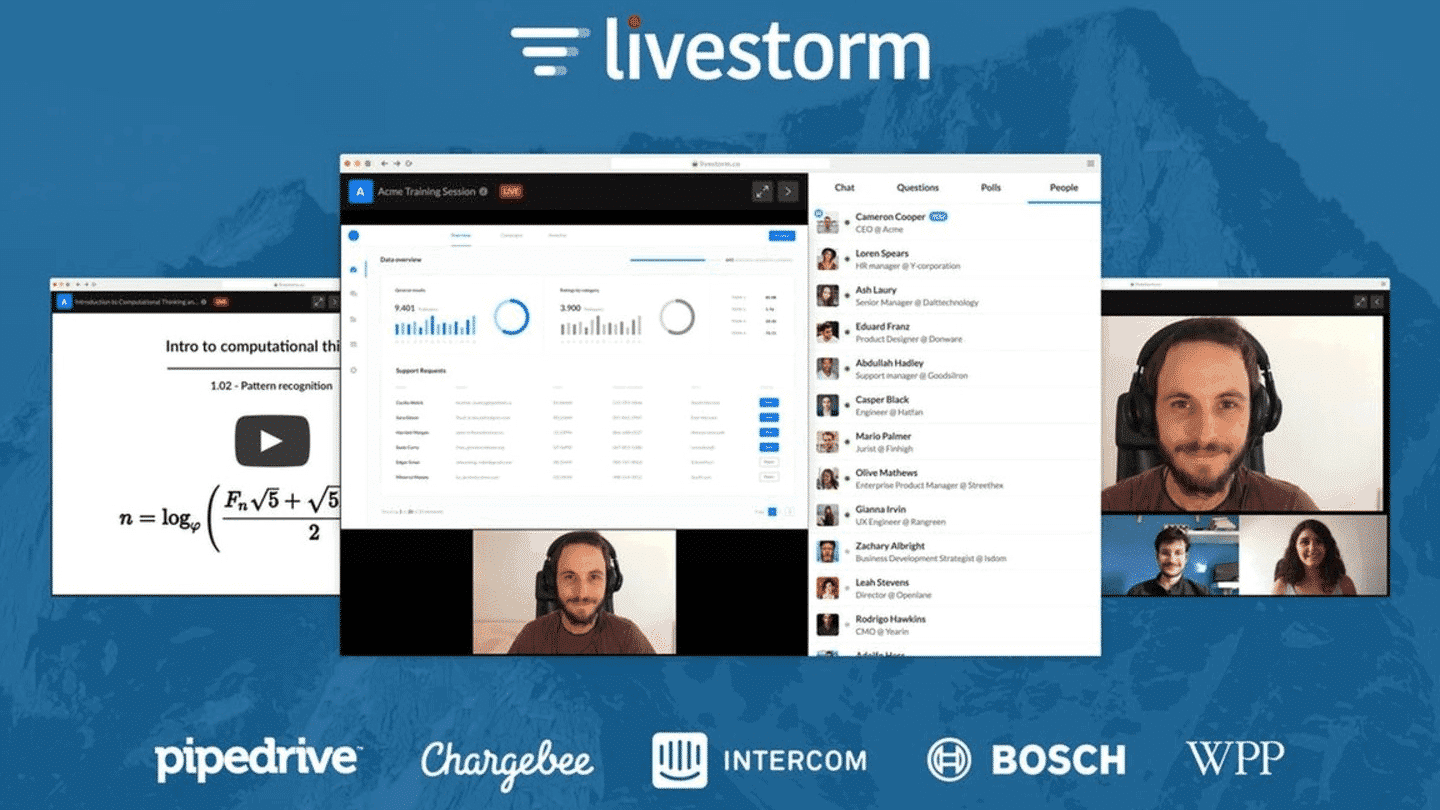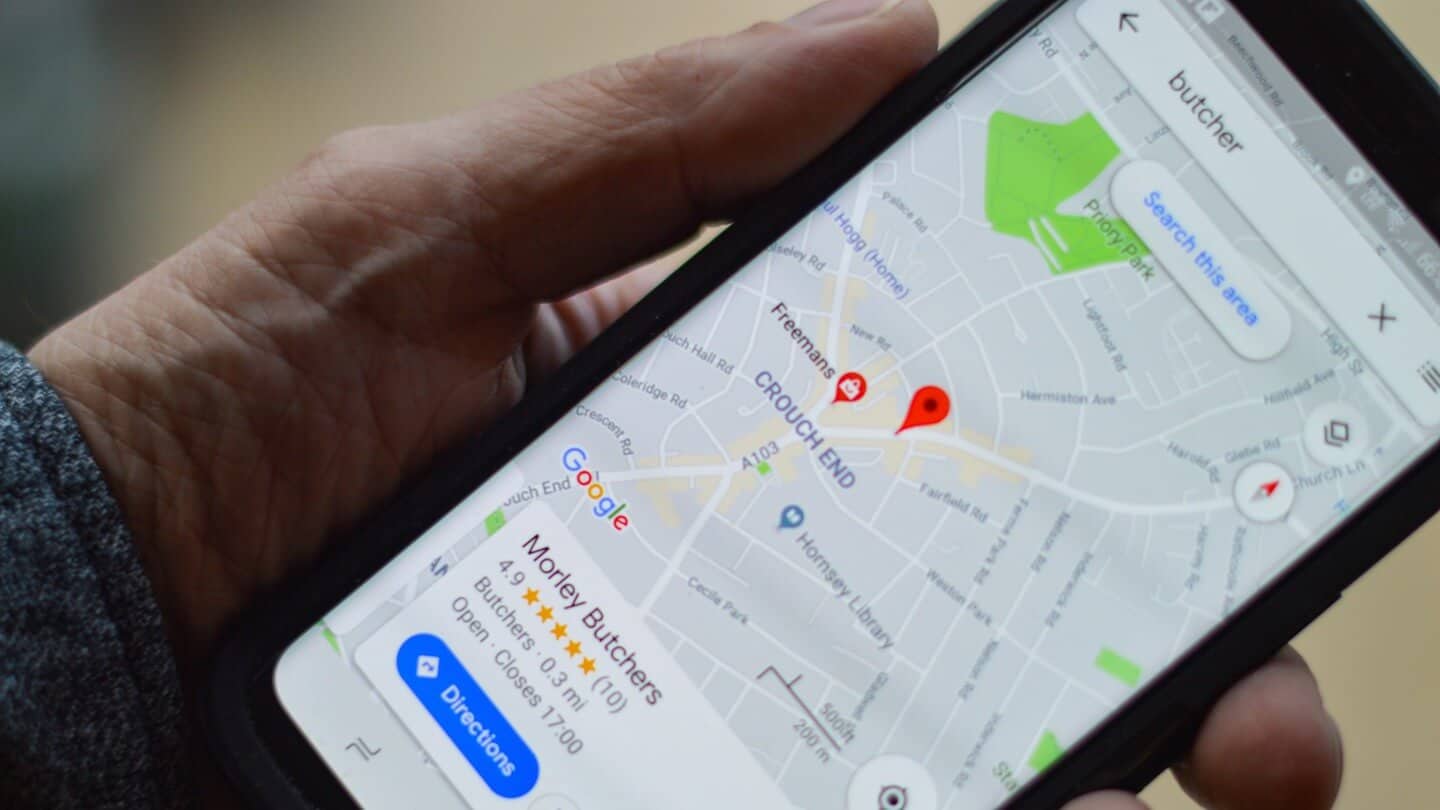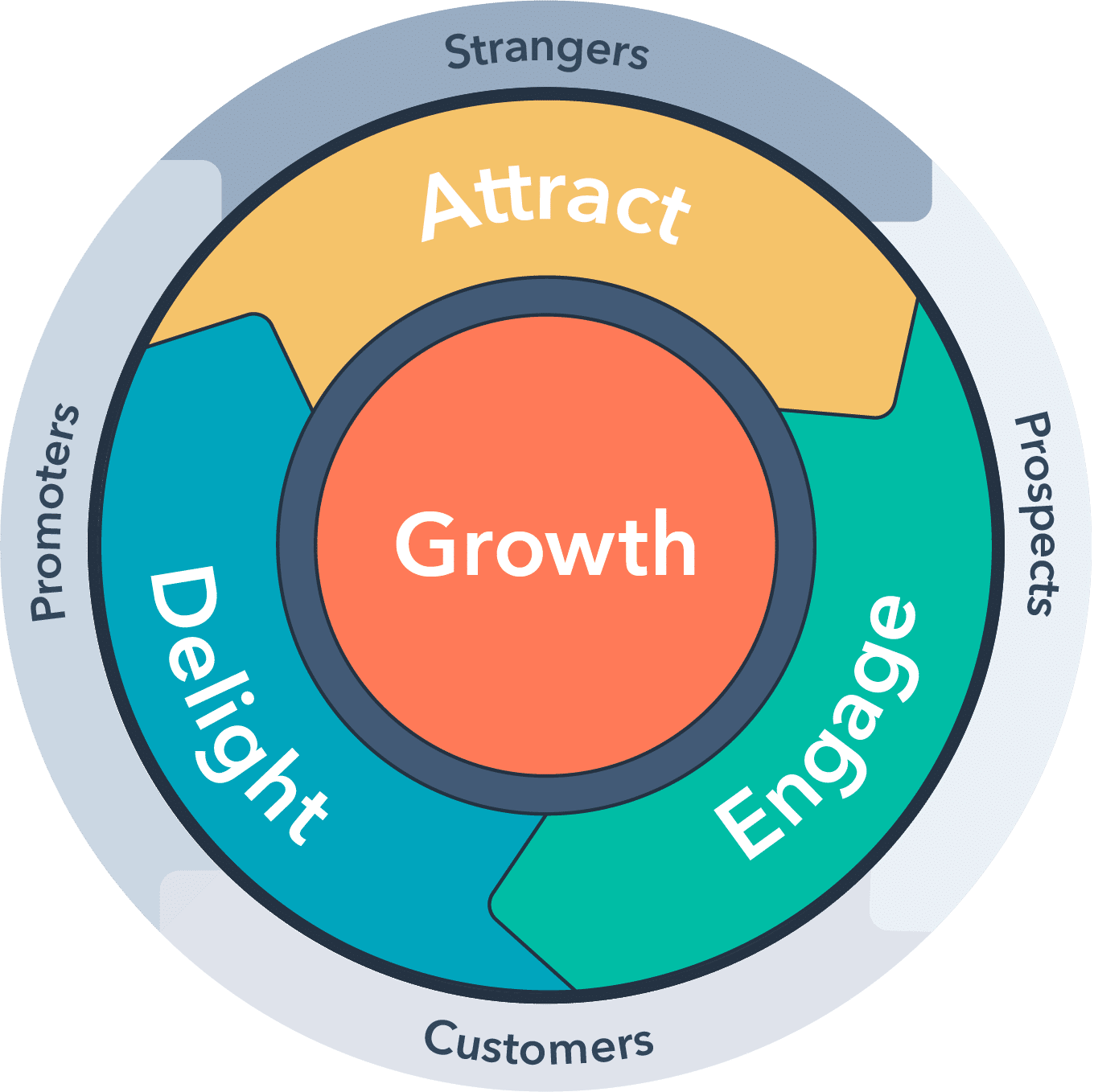Inbound Marketing
Inbound marketing is a strategy of getting leads to you by offering just enough value for free.
Concretely, this was theorized by Hubspot and the flywheel model which breaks down the inbound marketing strategy into three steps: be present, be relevant and be great.
It sometimes seems that this subject has become ultra-specialized and reserved for experts, but here we give you our guide to inbound marketing to help you prioritize your actions.
Our definition of inbound marketing
Inbound marketing is the opposite ofaccount-based marketing, which focuses on a very small number of high-value prospects that we seek to engage through ultra-personalized campaigns. Instead, we focus on quality, seeking to increase the value of our existing customers.
Hubspot’s flywheel model explains the inbound methodology very well: the goal is to give momentum to your wheel so that it becomes self-sustaining and you gain new customers (for example, satisfied customers who share it with their friends and family).
To turn the flywheel, Hubspot proposes 3 steps:
- “Attract”: it’s about attracting the right people with valuable content that makes you credible and makes them want to engage with you.
- “Engage”: present them with ideas and solutions that meet their needs.
- “Delight”: provide help and assistance to enable your customers to make a successful purchase.
In concrete terms, this means being present and relevant at all stages of the customer journey, as customer journeys become increasingly complex and multi-channel. More than ever, this requires an excellent knowledge of your audience and your product or service.
Inbound marketing is partly based on attribution models. And the latter have evolved a lot since the 2000s according to the amount of data collected, allowing for the design of more refined campaigns. For example, retargeting had exploded between 2000 and 2010 because there was a lot of data on buyer profiles, via Facebook, etc.
With the RGPD and cookie laws, this is no longer possible: either you do generic campaigns, or you do campaigns on much finer and controlled segments, and not automated at all – this is very contradictory with the development of AI. For example, the 3rd party cookie, which allows Meta to cross-reference Facebook profiles with their web history, is now prohibited without explicit consent (opt-in) and blocked by modern browsers.
Learn more about attribution models.
Going further
- The flywheel model explained by Hubspot
- The difference between Inbound Marketing andAccount-Based Marketing
- The guide to lead generation
- Our best lead generation strategies, for a more holistic view of inbound marketing
The levers of inbound marketing
According to Hubspot’s flywheel, there are three major levers of inbound marketing: “attract”, “engage”, “delight”.
Attention
We often hear about the customer journey and the idea of helping customers move from one phase to another. This is total heresy: as a marketer, your role is not to “educate” the market or “convert” customers. We don’t convert anyone, the customer buys when they are ready to buy. Marketing is about being there at that moment: good marketing is about being seen, relevant, and convincing (but not on the same lead segments).
The same goes for the notion of market education, which is completely disconnected from reality. It’s up to the company to find its market, not the market to find your product. Thinking the other way around only leads to bad thinking and campaigns that don’t work.
Going further
We offer you our best articles to discover the inbound marketing.
#1 Be present (Attract)
The idea here is to be present at all stages of the funnel: TOFU (Top of the Funnel), MOFU (Middle) and BOFU (Bottom).
For example, if you want to do inbound marketing on inbound marketing. On Google, this translates into the following keywords:
- Inbound marketing definition (TOFU)
- Examples of inbound marketing strategies or Best inbound marketing tools (MOFU)
- Sendinblue VS Mailchimp (BOFU) or Sendinblue Notice
Being present means being able to capture these intentions. And it is already very difficult.
Because to be able to attract your prospects, it is not enough that your site appears on the SERP for each of these keywords: the “SERP domination”, or “Surround Sound Effect“This is about being present in all results on Google – instead of just one Adwords result (Google ad) and one organic result (SEO).
Whether it is on the BOFU (the most profitable in the short term), the MOFU (more volume but less close to conversion) or the TOFU (even more volume and even further from conversion).
If you want to go further, you can expand the segments in which you want to be present:
- Customers: the most glaring example is a brand’s defensive strategy on Google Adwords – if someone advertises on your brand name, you have to pay Google to be on top, and “keep” the traffic. Even if the customer who clicks on a competitor’s ad after having typed a specific brand in Google will quickly realize that he was mistaken, and will probably come back to your site, “being present” is part of the game: this is often called the “Google Tax”.
- Partners: to become a “platform” when you are a SaaS for example, you must make people want to build a partnership or an integration with you. Hence the importance of being present on related queries. We can also extend the reasoning to agencies that are important influencers especially in SaaS, or to bloggers with a good affiliate program (and try to be present on keywords like “Best affiliate programs”, etc.).
We can also extend far beyond the Google results pages:
- Social networks obviously, but keep in mind that you have less control over the funnel stage since there is no intention (no keyword) so you have to be smart.
- Events and trade shows
- Community” marketing (newsletter sponsorship, podcasts, Slack communities, etc.)
- Display, television, radio, product placement, etc.
Going further
Our best articles to attract more leads:
#2 Be relevant (Engage)
This is what is often (mis)translated as “Convert”. The idea here is to bring value. This is one of the fundamental pillars of inbound marketing, and it is often shortened to “inbound marketing is white papers and webinars”.
This is somewhat true in the sense that inbound marketing assumes that at some point, you need a conversion, or more precisely, several “micro-conversions”. It is these micro-conversions that bring your prospects closer to your solution or brand.
But not because it “forces” them to a more advanced point in the buying journey. Because you are, or remain in the shortlist.
Moreover, the most immediately profitable and effective inbound marketing is the inbound marketing that consists in being in the shortlist at the very end of the funnel. The others will have worked the TOFU & MOFU, and may (or may not) be present at the bottom of the funnel, but if you are excellent at the bottom of the funnel (i.e. everywhere, and relevant), you will also be in the shortlist.
There is a common misconception about inbound marketing/content marketing that it is very time consuming, and a long term investment. It’s a bit of a mess. If you position yourself on a keyword like “Best alternative to Salesforce for French SMBs”, you will immediately be in the shortlist of companies that are very advanced in their purchasing process. It remains to be convinced that you are the best alternative to Salesforce for French SMEs.
So you can choose to be relevant at all stages of the funnel, and why not without a white paper or webinar.
The main issue is to be aligned with the needs of your prospects and customers at every interaction. When you start, it’s best to master these interactions and make sure you’re really relevant every time.
Basically, don’t start at the end and try to be relevant everywhere. It’s better to be very relevant at the end of the funnel than to be slightly relevant throughout the buying journey.
Then, we can try to develop two things:
- You can increase the volume of inbound leads, either by moving up the funnel (from BOFU to TOFU) – or by looking to extend the BOFU, MOFU, or TOFU to other segments (other buyer personas, or other ICPs)
- But you can also develop conversion rates – this is the mantra of copywriters, CRO (Conversion Rate Optimization) experts, and quite generally of many consultants and “growth hackers”.
Attention
Beware here of the gimmicky effect of A/B test landing pages, the color of buttons, or other.
The best CRO is to be even more relevant. And very often, it comes down to a trade-off between segmentation and operational complexity. Operational excellence is what makes the difference here.
A very simple example: You target 3 keywords “newsletter software”, “emailing software”, and “email marketing software”. First, you start with a generic adwords campaign with the same ads (same text), the homepage as a landing page (generic to address all 3 intents), and the same welcome email for those who sign up.
- Then, you segment a bit: 3 keywords, 3 different ads, but the same landing page.
- You segment a bit more: 3 keywords, 3 different ads, and 3 different landing pages.
- A little more: You adapt the messages of your ads and landing pages to the associated maturities:
- Newsletter: this is a very generic keyword, and it is the first level in direct marketing and lead nurturing. You use very simple, reassuring words, and you address an audience that is not very mature on the subject. You don’t educate a market, but you can be educational on the landing page. In terms of features, you would rather highlight the template library, the options for importing contacts (especially the “easy” options – copy and paste / integration with excel, etc.), and the ease of use. You have to show the product, with accelerated videos, screenshots, etc.
- Emailing: it’s a bit of an old school keyword. A priori, you are addressing an audience that knows the subject well enough, but not very technical, and that will be unaware of the methods of capture, RGPD, the notion of opt-in etc. Social proof is important here to show that you know what you are doing, that you are reliable and solid, and that you know what you are talking about. Not too much technical jargon, but precise vocabulary. In terms of functionality, you would rather highlight the template library, the campaign editor, the contact list management tools, and the integrations.
- Email marketing: it’s an English word. Your audience is googling in English, has read quite a bit, and probably knows the basics about capture, regulation, and best practices on list hygiene and campaign management itself. Social proof is important, and it is especially important to demonstrate that you are “up to speed” – Still no jargon, but small deviations are tolerated to “check the boxes”. In terms of functionalities, you will rather highlight A/B testing, sending time optimization, campaign editor, and contact list segmentation tools.
- A little more: you adapt the welcome message
- Even more, you offer different downloadable content in your welcome message
- Even more, you set up different retargeting campaigns on these audiences
Attention
The balance between the team’s operational capacity and performance gains is achieved much faster than one would like to believe. Real” CRO is about minimizing operational complexity as you segment more finely, not about changing the color of the buttons.
Going further
Our best articles to propose a content always more relevant:
#3 Be excellent (Delight)
Once you manage to be present, and relevant, you have to be excellent, and “delight” your prospects and customers. This is kind of where inbound marketing takes a much more macro turn, and is not limited to just the marketing team.
The product or service itself, the quality of interactions with each person in the organization (customer support, sales team, and all marketing communications) are all part of the scope.
This obviously requires a great deal of communication skills, but also a lot of information. And that’s kind of the whole point.
If each communication must bring value to the customer, its role is not to “convert”, but rather to refine the qualification and obtain more information, to be even more refined in the following communications.
This is the fundamental trade-off in inbound marketing: you give value, and you get information in exchange. We can feel the limit with the increasing regulation on personal data, but we must not lose sight of that. We are not trying to “convert”, but to be more precise.














